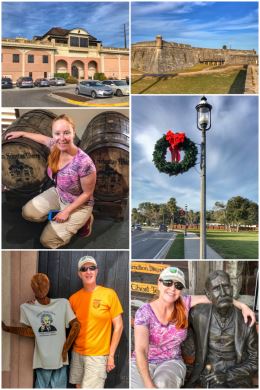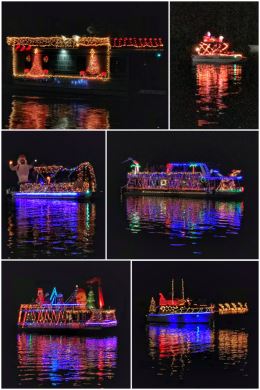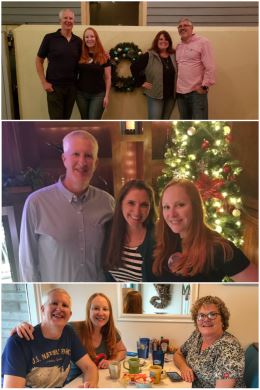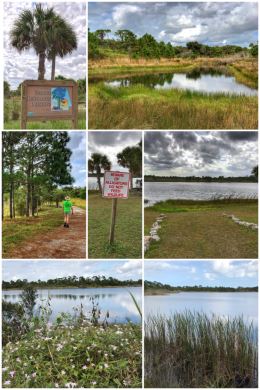
We returned to Florida almost exactly two years since we last visited the state when Jen was attending a residency for her master’s degree. It is still hot and humid — but better than being caught in a blizzard with our travel trailer! Florida is amazingly state #44 for us; only 4 more to go to achieve this trip’s goal of visiting all 48 continental states.
We started our adventures in St. Augustine, the oldest continuously inhabited European-established town in the United States, founded back in 1565! It has been under Spanish and British rule, before finally becoming part of the Florida Territory in 1819. Today, there is no question that St. Augustine — and especially the Historic District — is a tourist attraction. And one of the top spots for many is St. George Street, a pedestrian/retail thoroughfare where one can stroll unencumbered by vehicle or even bicycle traffic (but LOTS of foot traffic). St. George Street includes lots of shops, bars, restaurants — and people-watching.
Other destinations in and around St. Augustine include the Castillo de San Marcos (the oldest and largest masonry fort in the continental U.S., dating back to 1672), the St. Augustine City Gates (built in 1808), Ponce de Leon statue, Lightner Museum (located in the former Hotel Alcazar), Bridge of Lions (that spans the Intracoastal Waterway), and St. Augustine Lighthouse. Of course, you might start where we did — at the St. Augustine Visitor Information Center — located on the corner of West Castillo Drive and San Marco Avenue. (Hint: You can park at the parking garage right next to the visitor center and pay a huge fee — or park for free a few blocks away on a side street.)
Like other touristy towns, you can park your car and walk around — or use the Old Town Trolley Tours, which offers 23 hop-on, hop-off stops on a narrated trolley. (They also offer a “ghosts and gravestones” night tour.) There are also multiple tourist attractions, such as the Fountain of Youth, Potter’s Wax Museum, and Alligator Farm.
While in St. Augustine, we also got back on our wine-tasting gig (of tasting wines from all 48 states), with an unexpectantly excellent visit to San Sebastian Winery, located on King Street (just a few blocks from downtown). To make things even cooler, the winery is located in one of Henry Flagler’s old East Coast Railway buildings. The winery recently added a third-floor wine bar that features live music, food, and beer and wine. The winery offers free tours and tastings — starting with a very informative video of the history of the winery (and its sister winery, Lakeridge Winery & Vineyards, located in Clermont, Florida). Their vineyard grows three varieties of Muscadine grapes — Noble, Carlos, and Welder — that are native to the Southeast (which means they are disease-resistant and thrive in the warm, humid climate). The tasting takes place in one of the barrel rooms — and you have the choice of five tastings. We went a bit crazy, falling in love with the light and fruity Vinter’s Red (buying a case of it!) as well as one bottle of the Ruby Port and Blanc De Fleur (a sparkling wine we plan to pop open on New Year’s Eve).

We also decided to get our nature and hiking fix with a stop at the Guana Tolomato Matanzas National Estuarine Research Reserve, located in Ponte Vedra Beach — about 26 miles north of St. Augustine.
The 73,256-acre reserve — located along the Guana, Tolomato, and Matanzas Rivers — is one of 29 National Estuarine Research Reserves in the country, all with a mission to protect and provide for a great diversity of plants and animals. The reserve is open for fishing, hiking, bird-watching, picnicking, kayaking, horseback riding. It has about 15 miles of hiking trails — all of which start near the entrance to the Environmental Education Center. We parked near Guana Lake (although there is another parking area closer to the trailhead), and walked past all sorts of folks fishing in the river and lake. Once we crossed over to the trailhead, we decided on the Yellow Trail, a 2.2-mile trail that leads to the Tolomato River. (Our hike ended up being about 3.5 miles long because we wandered along the river a bit.)
From St. Augustine, we traveled down to central Florida — more specifically, to DeLand and to a new RV park that did not exist when Ran used to live in the area. The KOA is situated right along the St. John’s River. This river is unique in that it is not only the longest river (310 miles) in the state, but it flows north. The KOA is located just past Ed Stone Park.

We put on our hiking boots and visited Lake Woodruff National Wildlife Refuge, located in DeLeon Springs, just north of DeLand — and not far from the historic 625-acre De Leon Springs State Park (named for Spanish explorer Juan Ponce de Leon as a marketing scheme to get people to visit the park). The 21,574-acre refuge was established in 1964 to protect habitats for both migrating and wintering birds (including 21 species of ducks) — and includes marshes, swamps, creeks, flatlands, hammocks, and pools. (As we have seen with many other wildlife refuges, part of what is now refuge land was attempted for agricultural use when a developer constructed levees and installed pumps designed to drain the land. Happily, this venture failed.) The St. Johns River forms the western boundary of the refuge. Much of the refuge is only accessible by boat, but there are also hiking trails. The Lake Woodruff Wilderness Area is part of the refuge and consists of 1,066 protected acres. The refuge has a visitor center, but it was closed the day we visited.
The full Lake Woodruff National Wildlife Refuge Loop Trail runs 6.5 miles, but there are multiple options for making the hike a shorter loop. For example, we hiked a 3.2-mile loop that day (circling Pool 3). About halfway through the main trail, there is a wildlife observation tower that provides wonderful views in all directions. The refuge also has a few shorter trails, including the .5-mile Hammock Trail and the .5-mile Live Oak Trail.

The next day, we decided to take advantage of some nice weather and get back on our bikes for the Spring-to-Spring Trail, using Lake Beresford Park in DeLand as the trailhead. The park is part of the Lake Beresford Greenway, a 211-acre parcel that was acquired with assistance from the Florida Communities Trust in 1991.
We started the bike ride on the paved 1.8-mile park loop trail before jumping on the Spring-to-Spring Trail by crossing under the railroad tracks. This trail will eventually be 26 miles long, connecting Deltona in the south to Deleon Springs in the north; it currently has 22 miles completed — though in three segmented sections. The north section runs along quiet roads near where we hiked in Lake Woodruff National Wildlife Refuge. The section we biked is an 8.9-mile segment that runs from Lake Beresford Park into the town of DeBary, paralleling the railroad for much of the journey through lush forests and swamps. This segment also passes by Blue Springs, which we visited two years ago, and home to more than 300 wintering manatees — Florida’s state marine mammal, and, amazingly, a large (and gentle) aquatic relative of the elephant. These sea cows can be viewed floating near the surface from several raised platforms — and you should make sure this 2,643-acre park is on your must-see list when traveling in Central Florida. We ended up biking about 11 miles, which in the hot and humid Florida weather was fine with us!

That night, we experienced a first — watching boats decked out in Christmas lights traveling up the St. John’s River, just several hundred feet from our campsite.
The DeLand St. Johns River Christmas Boat Parade is held every December; this year it was held on the 14th. It’s been a tradition for more than 50 years — and even though Ran lived in DeLand when he taught at Stetson University, he never got a chance to see the boat parade!
The boat parade starts in Lake Beresford (north/east side) about 6 pm and travels along the shores of the lake to the St. Johns River, where it passes Hontoon Island State Park (about 6:30 pm) and continues up the river northbound to the Whitehair Bridge (SR 44) and Ed Stone Park (arriving about 7:00 pm) and ending just past the St. Johns Marina North River Grille… which is where we parked our camp chairs to watch the procession!
As you can see in the collage, boats of all sizes — with tons of lights and other Christmas decorations — took part in the parade. The atmosphere was festive and we enjoyed watching both the boats and the people on shore (drinking up the holiday spirits) watching the boats!

We concluded our time with a visit to where the boat parade started — and another DeLand experience Ran had never done before: Hontoon Island State Park, located about 6 miles southwest of DeLand. The 1,648-acre park protects Hontoon Island, which sits between the St. Johns River and the Hontoon Dead River (and Snake Creek). Because it is an island, it can only be reached by personal watercraft — or by the park’s (free) ferry. The park has a variety of ecosystems, including beautiful Pine Flatwoods, Palm and Oak hammocks, Bald Cypress swamps, and marshlands.
The park includes camping tent sites and rustic cabins, boat camping (with 42 accessible boat slips available with water and shore power), picnic areas, restrooms, a playground, boat (canoe and kayak) and bicycle rentals, and eight miles of hiking trails. The park also includes a small store and an informative visitor center.
We hiked the most popular trail in the park — the 3-mile (RT) Hammock Hiking Nature Trail, which ends atop an ancient Native American Indian Shell Mound. We explored a bit more of the island — including checking out the campground and one of the cabins — and ended up hiking about 3.7 miles.
The highlight of the day came just after we left the park as two pairs of sandhill cranes were walking in a grassy field — and making their crazy loud bugling calls. Sandhill cranes are beautiful, long-legged, long-necked, gray, heron-like birds with a patch of bald, red skin on top of their heads. The Florida sandhill crane can reach a height of 47 inches, with a wingspan around 78 inches. Cranes are monogamous, mating for life, and inhabit freshwater marshes, prairies, and pastures.
While in Central Florida, we also attended another wonderful Jazzercise class — at the Jazzercise Orlando Lake Mary Fitness Center on Rinehart Road. The ladies there were wonderfully friendly and we had a great workout. And, of course, we also got in more shopping (and gas) at the Altamonte Springs Costco Wholesale (#183).

We ended Part One of our Florida trip in Fort Pierce to visit with Ran’s Cousin Gretchen… who he had not seen for several decades. Gretchen is the daughter of Ran’s mom’s brother… so a direct cousin. We lamented how easy it was to lose touch after the older generation passed away — and the many of the younger generations left New Jersey, where we all grew up. We had an amazing time catching up with Gretchen — and she and Jenny made an immediate bond. We had a blast sharing stories of our childhood get-togethers, as well as catching up on our adult lives. Can’t say enough how meeting up with long-lost family members has been a wonderful and unexpected joy of this trip.
We also reconnected with special friends that we happily had seen somewhat more recently (two years ago when we were in Florida for Jenny’s residency), including Stacey and George, who like us, have found true love the second time around — and are such fun and funny people; we had a nice dinner out at a farm-to-table restaurant in St. Augustine. We also got to spend some time (but not enough) with our dear friend Jessica, celebrating love and new beginnings, as well as friendship and Christmas; Jen and Jessica made plans for a night out dancing, while Ran simply sat back and enjoyed the conversation and connections!
If we have any lessons from this trip, one has to be to find the time to stay connected with family and friends — and find ways to visit. We’re hoping for a cousins visit, as well as visits from friends far and wide once we finish building our Hansen Hilltop Haven (H3) in eastern Washington.

While in Fort Pierce, we also got in a bit of hiking in… first at the D.J. Wilcox Preserve, which has two parking areas; we parked off Michigan Street, which provides access to two trails. The 105-acre park borders the Indian River Lagoon and includes an interior 1-mile self-guided interpretive trail that identifies the common species of plants in the park — which include Pine Flatwoods, Mangrove Swamp, Oak Hammock, and Bay-Gall Swamp. (There is also an observation tower along the trail, but some massive flooding kept us from hiking to it.) You can also walk down an old road lined with canals and hike on a levee along the lagoon. (The old road had been used to reach a commercial wharf, now long gone, that was part of a little community called Indrio back in the 1920s.) We did both hikes, which totaled almost 3 miles. The park is named after D. J. Wilcox, past owner of the property, and a St. Lucie County Commissioner in the 1930s and 1940s.

St. Lucie County has some amazing parks and natural spaces, so we completed our time in the area by hiking at the George LeStrange Preserve. The 94-acre park includes a 1.2-mile hiking trail that travels through Pine Flatwoods, Palm Hammocks, and floodplain forest — circling the 37-acre “lake,” a former sand mine. You can extend the hike by taking an additional loop in the back of the park. The county plans to connect the park with several miles of proposed trail along Ten Mile Creek and the North Fork of the St. Lucie River. The park is named for George E. Lestrange (1912-1962), who loved the outdoors, and was an avid fisherman.
We have to say that St. Lucie County rocks in terms of natural spaces. The county’s Environmental Resources Department (ERD) manages more than 30 current and future sites — with more than 10,000 acres of preserves and natural areas — including beautiful sandy beaches on the east side of the county to the ranchland restorations and cypress hammocks on the western side.
Next up we hit South Florida and the opportunity of visiting three more national parks!
